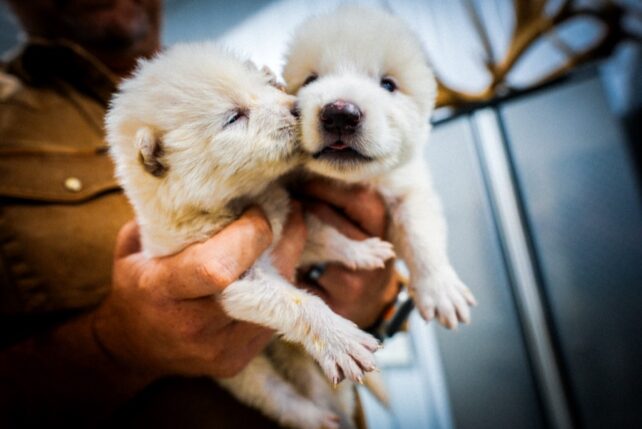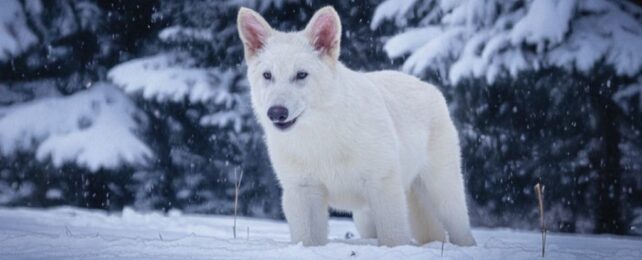The internet is currently abuzz with talk of dire wolves – an extinct species of prehistoric wolf that used to roam North America and that was famously featured in the HBO fantasy series, Game of Thrones.
A Dallas-based biotech company, Colossal Biosciences, claims to have resurrected the prehistoric Ice Age species (Aenocyon dirus) in the form of three genetically engineered grey wolf pups named Romulus, Remus, and Khaleesi.
"On October 1, 2024, for the first time in human history, Colossal successfully restored a once-eradicated species through the science of de-extinction," reads the company's official press release.
"Colossal's innovations in science, technology, and conservation made it possible to accomplish something that's never been done before: the revival of a species from its longstanding population of zero."
With thick pelts not seen in modern wolves, the white-furred pups may well pass for a distinct new type of wolf, but in the words of American astronomer and science communicator Carl Sagan, "Extraordinary claims require extraordinary evidence."
Right now, details of the non-peer-reviewed research are very limited. All the public has to go on are images and quotes provided by Colossal.
Jeremy Austin, Director of the Australian Centre for Ancient DNA, told ScienceAlert that all Colossal has done is create a genetically engineered gray wolf that looks like what the company thinks a dire wolf might have looked like. And even that is up for debate; canids are morphologically similar, making it hard to verify from fossil remains the exact appearance of an extinct member of the family.
Evolutionary biologist Beth Shapiro of Colossal has given a definition of a species that Austin finds misleading.
"Species concepts are human classification systems, and everybody can disagree and everyone can be right," Shapiro told Michael Le Page at New Scientist.
"I think that the best definition of a species is if it looks like that species, if it is acting like that species, if it's filling the role of that species, then you've done it," she told ABC News.
But looks aren't everything. Cryptic species, for instance, are organisms that are almost indistinguishable but are genetically distinct and do not typically interbreed.
Austin compares Shapiro's lenient definition to the literary folktale, the Emperor's New Clothes.
"If you say you've done something, and enough people believe you, then, well, you've done it," Austin told ScienceAlert.
"Whereas I think a lot of scientists are going to be scratching their heads, saying, 'Look, you've got a white, gray wolf.' That's not a dire wolf under any definition of a species ever… I don't think that this represents de-extinction in any way, shape, or form."

Adam Boyko, a geneticist at Cornell University who was not involved in the project, told Carl Zimmer at the New York Times that he also doesn't consider Romulus, Remus, and Khaleesi to be 'resurrected' dire wolves.
Though closely related, studies on their genes have found dire wolves split from other canids around 5.7 million years ago, with no sign of an exchange of genes with North America's gray wolf ancestral populations.
To create these pups, scientists at Colossal used past genetic sequencing studies to make just 20 unique precision edits among the 2.5 billion base pairs in gray wolf germline cells. They then used surrogate dog mothers to give birth to the genetically engineered gray wolf pups.
Colossal hasn't claimed an intention to make a genetically precise dire wolf. But even if they are trying to create a wolf that looks and behaves like they think a dire wolf would, Austin says that would still probably require tens of thousands if not hundreds of thousands of critical genetic changes.
Five of the 20 gene edits made to the gray wolves were apparently associated with light coat color alone, according to New Scientist's interview with Shapiro.
The chief animal officer at Colossal who oversaw the pregnancies and births, Matt James, told the New York Times that when the pups were born, he could tell they were a success the moment he spotted a white coat.
Austin admits that this research is valuable, with real applications in conservation, genetics, and understanding the evolutionary development of different organisms.
But he says, "for a fully trained wolf biologist or wolf taxonomist or a wolf evolutionary biologist to come out and say, 'I know we have a dire wolf because it was white', is really cutting so many corners in terms of resurrecting extinct animals… it kind of brings the whole thing into real disrepute."
Colossal claims that they are proud to return the dire wolf to its "rightful place in the ecosystem." But is it really their 'rightful place', or will they threaten other animals that have not gone extinct? It's also worth considering if the ecosystem dire wolves once used to live in even exists anymore.
"Is there an ecological place for dire wolves in the modern world?" wonders Austin.
"Or are they just zoo animals that people are going to go and pay money to see and say, 'Hey, we saw a dire wolf today', while Jeremy is standing in the background saying, 'No, you didn't see a dire wolf. You saw a white gray wolf'."
"It's a bit like the guy in the Chinese zoo who had dogs that he painted to be pandas. And everyone you know fell for that story."
